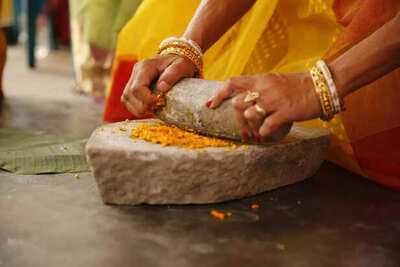
In a world rushing towards perfection—of makeup, of moments, of marriages—the Haldi ceremony forces a bride to slow down. To sit. To let herself be seen. Covered in turmeric, surrounded by noise and laughter, she prepares—not for the spotlight, but for the silence that comes after. This ritual, often reduced to a “bridal glow” tradition, holds something deeper than skincare. It is not about making the bride beautiful. It is about making her ready.
1. Turmeric Isn't Just for Skin. It's a Signal

Turmeric cleanses memory, not just skin.
For thousands of years, Indian culture has known what modern science is only beginning to articulate: the body holds memory. And before a woman steps into the most remembered chapter of her life, she must cleanse—not just her skin, but her past. Turmeric, in its warm yellow honesty, says: shed what was. Wipe it away. Go forward clean. Go forward whole.
The glow is not aesthetic. It’s symbolic. She’s not “glowing” because she’s getting married. She’s glowing because she’s choosing to let go. Every major event — birth, marriage, death — involves cleansing. Turmeric (Haridra) is mentioned in Ayurveda and Atharva Veda as a sacred, protective, cleansing herb.
2. Everyone Touches You So You Remember: You Are Not Alone

Each touch is a blessing. You’re never alone.
One by one, they come. Sisters. Cousins. Aunts who still call you by childhood nicknames. Each with a handful of Haldi, each with a blessing hidden in their palm. They smear it on your arms, your face, your feet. And you sit there, not performing, not posing—just receiving.
This is not about decoration. It’s about protection. About community. About collective care. Before the vows, before the ceremony, this is the quiet promise of your people: We are with you. Hinduism teaches that energy is transferred through touch, mantra, and intent. When family members anoint the bride with turmeric while offering blessings, they’re essentially doing a folk version of a Vedic “Sankalpa” — charging her with positive energy.
3. It’s Messy on Purpose

Imperfection is intentional. This ritual embraces real life.
Nothing about this ritual is curated. No one’s using dainty brushes. No one’s worried about turmeric stains. That’s the point. It’s not meant to be neat. This is the in-between moment—between girlhood and womanhood, between independence and interdependence. It is the permission to be unfinished. It is chaos with intention.
Because life won’t always be photogenic. Love won’t always be graceful. This mess is practice. It represents returning to nature, to origin. Most sacred rituals (pujas, homas, japas) are done seated on the ground or a mat, to be closer to the Earth (Prithvi), who is a Goddess and a witness. Marriage is a sacred life rite. The Haldi is part of that inner preparation.
4. You Sit on the Floor, Because You’re Becoming Grounded

Humility comes before grandeur. Grounding begins on earth.
In a culture that has made weddings a stage for grandeur, Haldi takes you back to the ground—literally. You sit cross-legged, in old clothes, as the world celebrates your simplicity. It reminds you: before you wear the jewels, feel the soil. It’s a sacred return to humility. The kind that says: what you are becoming must grow from where you came. This shows: it’s not about “looking good.” It’s about cleansing, protection, transition. Turmeric (Haridra) is used in: Rituals to ward off the evil eye, Puja offerings to Goddess Durga & Lakshmi and purification.
5. This Is Not About Preparing for a Man. It’s About Becoming a Woman

The ritual is for her becoming.
Haldi has often been misunderstood as a beautifying ritual for the bride, meant to please or impress her future husband. But that’s not what it is. Not if you really look. The ritual is hers, not his. The turmeric is for her—not to look better, but to feel lighter. To step into herself with more clarity, more grace, more courage.
It is not a makeover. It is a mark of metamorphosis. Hinduism is not one monolithic patriarchy. The Shakta and Tantric traditions see woman as the source of Shakti. In these systems, the rite is as much about her inner awakening as it is about the social bond.
Conclusion:
We’ve started calling Haldi a “function.” Like it’s a checkbox. A pre-wedding event that precedes the “main one.” But maybe it’s time we remembered: this is the main one. Because what could be more sacred than a woman being asked to pause before she becomes something new? To sit in the middle of her loved ones, stripped of filters and expectations, and to be covered—messily, imperfectly, wholly—in love?
Turmeric doesn’t just stain the skin. It marks the moment. And maybe that’s what rituals are for—not to impress the world, but to imprint something deeper on the soul.
 In a world rushing towards perfection—of makeup, of moments, of marriages—the Haldi ceremony forces a bride to slow down. To sit. To let herself be seen. Covered in turmeric, surrounded by noise and laughter, she prepares—not for the spotlight, but for the silence that comes after. This ritual, often reduced to a “bridal glow” tradition, holds something deeper than skincare. It is not about making the bride beautiful. It is about making her ready.
In a world rushing towards perfection—of makeup, of moments, of marriages—the Haldi ceremony forces a bride to slow down. To sit. To let herself be seen. Covered in turmeric, surrounded by noise and laughter, she prepares—not for the spotlight, but for the silence that comes after. This ritual, often reduced to a “bridal glow” tradition, holds something deeper than skincare. It is not about making the bride beautiful. It is about making her ready.




